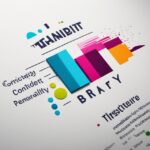Table of Contents
Personal branding plays a crucial role in determining your level of success, whether it’s for your business or personal life. Your personal brand is what people think of you and about you, and it can greatly impact the opportunities that come your way. Building a powerful personal brand involves defining your values, crafting your story, and staying consistent with your brand messaging.
When it comes to personal branding, your professional presence is key. It is how you present yourself to the world, both online and offline. A key aspect of your professional presence is your distinctive visual identity. Your visual identity is the first impression people have of you, and it shapes their perception of your brand. It encompasses elements such as colors, images, and design consistency across platforms.
Creating a strong visual identity is crucial in establishing your personal brand and standing out in a crowded marketplace. It is your opportunity to showcase your uniqueness and communicate your brand message effectively. A well-crafted visual identity can enhance your credibility, attract opportunities, and leave a lasting impression on others.
The Advantages of Personal Branding
A strong personal brand offers numerous advantages. It enhances your credibility and influences others to believe in what you say and do. Trust is another important aspect of personal branding, as it reflects people’s belief in your integrity and the level of safety they feel when working with you. Establishing an exclusive niche within your personal brand positions you as an expert in a specific area, giving you a competitive advantage. Moreover, a strong personal brand attracts opportunities as people see your competence and trustworthiness.
“A strong personal brand is like a magnet, attracting the right people and opportunities to you. It opens doors and paves the way for success.”
| Advantages of Personal Branding | Description |
|---|---|
| Enhanced credibility | Building a personal brand enhances your credibility, making others trust in your expertise and abilities. |
| Established trust | Personal branding reflects your integrity and trustworthiness, fostering trust in those who interact with you. |
| Exclusive niche | By carving out an exclusive niche within your personal brand, you position yourself as an expert, giving you a competitive edge. |
| Increased opportunities | A strong personal brand attracts opportunities as others recognize your competence and trustworthiness, leading to new ventures and collaborations. |
Investing in personal branding allows you to leverage these advantages and cultivate a powerful and impactful personal brand.
Building Your Personal Brand
Building a personal brand is a journey that requires time, focus, and intentional effort. To create a powerful personal brand, it is essential to incorporate key elements such as values, story, purpose, and brand consistency.
Defining Your Values
Values serve as the guiding principles that shape your decisions and actions, both personally and professionally. They define what you stand for and what you believe in. When building your personal brand, take the time to identify and articulate your values, as they will be the foundation upon which your brand is built. Your values should align with your true self and resonate with your target audience.
Crafting Your Story
Your story is a powerful tool that connects you with your tribe – your followers, clients, and customers. It communicates who you are, what you have experienced, and how you have overcome challenges. Crafting your story involves tapping into your unique experiences, highlighting your strengths, and sharing your journey authentically. A compelling and well-crafted story creates an emotional connection that resonates with others, building trust and loyalty.
“Your story is what sets you apart from everyone else. It is the unique tapestry of experiences and accomplishments that brings your personal brand to life.”
Defining Your Purpose
Clarifying your purpose is crucial when building your personal brand. It involves identifying the impact you want to make in the world and defining the change you wish to create. Your purpose provides a clear direction for your brand and helps you communicate your mission effectively. By aligning your personal brand with a strong purpose, you attract like-minded individuals who resonate with your message and are more likely to engage with your brand.
Brand Consistency
A powerful personal brand is built on consistency. Consistency in your messaging, visual identity, and overall brand experience creates a sense of trust and reliability. When your audience experiences consistency in your brand, they develop a deeper connection and confidence in your abilities. Ensure that your brand remains consistent across all touchpoints, including social media, website, and other communication channels.
Mentorship and Guidance
Seeking guidance from a mentor who has successfully built their personal brand can accelerate your own brand development. A mentor can provide valuable insights, share their experiences, and offer guidance on how to navigate challenges. Their wisdom and expertise can help you avoid common pitfalls, learn from their mistakes, and gain clarity on your personal brand strategy.
Building your personal brand is an ongoing process that requires continuous reflection, adaptation, and growth. By defining your values, crafting your story, clarifying your purpose, maintaining brand consistency, and seeking guidance from mentors, you can create a powerful and authentic personal brand that resonates with your audience.
The Power of Visual Identity
In today’s digital world, visual identity plays a significant role in personal branding. It is the face of your personal brand and speaks volumes before people even read a word. Your visual identity encompasses elements such as colors, images, and design consistency across platforms. Crafting a compelling visual identity is essential in conveying your brand message effectively and making a lasting impression.
The Role of Visual Identity in Personal Branding
Your visual identity is the first thing people see when they come across your brand. It is the visual representation of who you are and what you stand for. By carefully designing your visual identity, you can communicate your brand message, values, and personality to your audience.
“Your visual identity is like the window display of your brand. It should capture the essence of your personal brand and create a strong first impression.”
A well-crafted visual identity ensures consistency and cohesiveness in your branding efforts. It helps create recognition, familiarity, and trust amongst your audience. When your visual identity is aligned with your personal brand message, it strengthens your overall brand image and makes it easier for others to understand and connect with you.
The Elements of Visual Identity
Visual identity incorporates various elements, each playing a crucial role in representing your personal brand:
- Colors: Colors influence emotions and perceptions. Choosing a color palette that resonates with your brand’s personality and values can evoke specific feelings in your audience.
- Images: Images have the power to convey ideas, emotions, and stories. Thoughtfully selecting images that align with your brand message can enhance the visual impact of your personal brand.
- Design Consistency: Consistency in design elements such as logos, fonts, and graphics across all platforms reinforces brand recognition and establishes a professional image.
Creating a Compelling Visual Identity
When crafting your visual identity, consider the following:
- Brand Message: Your visual identity should align with your brand message and effectively convey what you want to communicate to your target audience.
- Audience: Understand your target audience and their preferences to create a visual identity that resonates with them.
- Consistency: Maintain consistency in your visual identity across all platforms to reinforce your personal branding efforts.
By investing time and effort into developing a powerful visual identity, you create a strong foundation for your personal brand. A visually appealing and cohesive brand image enhances your credibility, leaves a lasting impression, and sets you apart from others in your industry.
Key Takeaways
Visual identity is a vital component of personal branding. It represents your brand before people even read your content. By carefully designing your visual identity and ensuring consistency, you can effectively convey your brand message and make a lasting impression on your audience. Invest in creating a compelling visual identity to strengthen your personal brand and differentiate yourself in the digital landscape.
The Palette of Personality
Colors hold psychological weight and have the power to evoke emotions. When it comes to personal branding, choosing the right color palette is crucial. It not only resonates with your personality but also aligns with your brand message, creating a visual representation of who you are and what you stand for.
Different colors evoke different emotions and can be strategically used to enhance your visual storytelling. By carefully selecting the colors that represent your personal brand, you can create a silent storyteller that captivates your audience and conveys your message effectively.
Let’s explore the emotions associated with different colors and how you can utilize them in your personal branding:
Blue:
Blue is a color that exudes trust, reliability, and confidence. It is often associated with professionalism and stability. Incorporating shades of blue in your branding can help establish a sense of credibility and create a calm and composed image.
Red:
Red is a bold and vibrant color that symbolizes passion, energy, and excitement. It grabs attention and can be used to create a sense of urgency or evoke strong emotions. Adding touches of red in your visual identity can help convey your passion and enthusiasm.
Yellow:
Yellow represents optimism, happiness, and creativity. It is a color that sparks joy and attracts attention. Using yellow in your brand palette can help create a positive and energetic image that resonates with your audience.
Green:
Green signifies growth, harmony, and balance. It is often associated with nature and represents freshness and renewal. Incorporating shades of green in your branding can convey a sense of environmental awareness or a focus on well-being.
These are just a few examples, and there is a wide spectrum of colors to choose from. By understanding the emotions associated with different colors, you can select a color palette that aligns with your personal brand and evokes the desired reactions from your audience.
Visual storytelling is an integral part of personal branding, and color plays a crucial role in conveying your story effectively. When used strategically, colors can enhance your brand message, create a connection with your audience, and leave a lasting impression.
Next, let’s explore the power of images in personal branding and how they can help establish a visual connection with your audience.
The Image is Everything
Images play a significant role as visual anchors in crafting your personal brand. From your profile picture to the graphics you use, each image should reflect the essence of your brand and convey your unique identity.
Investing in professional and authentic photography is a valuable way to establish a visual connection with your audience. When your audience sees genuine and high-quality visuals, it helps build trust and credibility, creating a stronger bond between you and your audience.
Experimenting with visuals that express your uniqueness and showcase your brand personality can further enhance your personal brand. By incorporating visual elements that resonate with your values and story, you can create a visual identity that sets you apart from others in your industry.
“Your profile picture is the first impression people have of you, so make it count. Choose a photo that represents your brand personality and connects with your target audience. Remember, authenticity and professionalism go a long way.”
By carefully selecting and curating your images, you can create a visually cohesive and impactful personal brand that leaves a lasting impression on others.
Design Consistency Across Platforms
In today’s digital landscape, consistent branding is crucial for effective visual branding. To create a strong personal brand, it’s essential to maintain design consistency across all your platforms, including logos, fonts, and graphics. By doing so, you establish a cohesive brand image that makes it easier for your audience to recognize and remember you.
Consistent branding builds trust and reliability, which are vital elements in strengthening your personal brand. When your audience sees the same logos, fonts, and graphics across various touchpoints, it reinforces their perception of your brand’s professionalism and attention to detail.
“Consistency in branding is key to establishing a strong visual identity.”
The Power of Consistent Logos
Your logo is the visual representation of your personal brand. It acts as a symbol that conveys your brand’s values and identity. By using your logo consistently across all platforms, you create a memorable visual cue that reinforces your brand presence.
Ensure that your logo is displayed prominently on your website, social media profiles, email signatures, and any other platforms where your brand is represented. Consistency in logo placement helps build brand recognition and fosters a sense of familiarity among your audience. Aim for a clear and high-resolution logo that maintains its visual integrity across various sizes and formats.
Typography and Font Consistency
Fonts play a crucial role in creating a distinctive brand identity. Consistency in font usage across all your platforms helps to establish a uniform visual language. Select fonts that align with your brand’s personality and image. Whether it’s a serif, sans-serif, or script font, choose one or two fonts that capture the essence of your brand and use them consistently.
Apply consistent typography guidelines to your website, blog posts, social media graphics, and other branded content. This coherent approach to font usage reinforces your brand’s professionalism and enhances visual cohesion.
Graphics that Reflect Your Brand
From social media banners to marketing materials, graphics are powerful visual tools that communicate your brand’s message and personality. Consistency in graphic design elements, such as colors, patterns, and visual styles, helps to reinforce your brand’s identity and create a unified visual experience.
Consider using a consistent color palette that aligns with your brand’s values and reflects your brand’s personality. This consistency in colors enhances brand recognition and adds a visually appealing element to your overall brand image.
Utilizing graphics with consistent visual styles, such as icons, illustrations, or photography filters, further enhances your brand identity. Whether it’s a clean and minimalist style or a bold and vibrant one, select a visual style that resonates with your audience and remains consistent across various platforms.
Remember, consistency in branding goes beyond visual elements; it extends to your brand’s tone of voice, messaging, and overall brand experience. Strive for consistency in all aspects of your personal brand to create a memorable and impactful brand image.
Conclusion
Crafting a professional visual identity is an essential part of personal branding. Your visual identity, consisting of colors, images, and design consistency, helps convey your brand message and make a lasting impact. By investing time and effort in building your personal brand, you can enhance your credibility, attract opportunities, and leave a lasting impression on others.
Understanding the power of personal branding visual identity enables you to elevate your professional presence and create a distinctive personal brand. Your visual identity acts as a silent storyteller, capturing attention and conveying your values and purpose. It is an opportunity to showcase your personality and connect with your audience on a deeper level.
Building a strong personal brand requires consistency and authenticity. By maintaining visual consistency across platforms, including logos, fonts, and graphics, you establish trust and reliability. Consistent branding enhances recognition and reinforces your brand message.
In conclusion, personal branding with an impactful visual identity is a powerful tool for success. By understanding the role of personal branding and investing in your visual identity, you can shape how others perceive you, attract new opportunities, and build long-lasting professional relationships. Cultivate your personal brand, and let your visual identity speak volumes about your professionalism, expertise, and unique offerings.
FAQ
What is personal branding visual identity?
Personal branding visual identity refers to the visual elements, such as colors, images, and design consistency, that represent your personal brand. It helps convey your brand message and make a lasting impact.
What are the advantages of personal branding?
Personal branding offers numerous advantages, including enhanced credibility, increased trust from others, the ability to establish a niche expertise, and attracting opportunities based on competence and trustworthiness.
What elements are involved in building a personal brand?
Building a personal brand involves defining your values, crafting your story, and staying consistent with your brand messaging. It also requires identifying your purpose and the impact you want to make in the world.
Why is visual identity important in personal branding?
Visual identity plays a significant role in personal branding as it represents the face of your brand and speaks volumes before people even read a word. It encompasses elements such as colors, images, and design consistency across platforms.
How do colors impact personal branding?
Colors hold psychological weight and can be used strategically in personal branding to convey emotions and enhance visual storytelling. Choosing a color palette that resonates with your personality and aligns with your brand message is crucial.
Why are images important in personal branding?
Images are powerful visual anchors of your personal brand. From your profile picture to the graphics you use, each image should reflect the essence of your brand. Investing in professional and authentic photography can help establish a visual connection with your audience.
Why is design consistency important in personal branding?
Design consistency across platforms, including logos, fonts, and graphics, is crucial in personal branding. It makes it easier for your audience to recognize and remember you, building trust and reliability in your brand.
Why is building a personal brand important?
Building a personal brand is important as it can enhance your credibility, attract opportunities, and leave a lasting impression on others. It allows you to craft your professional visual identity and create a distinctive brand that sets you apart.













